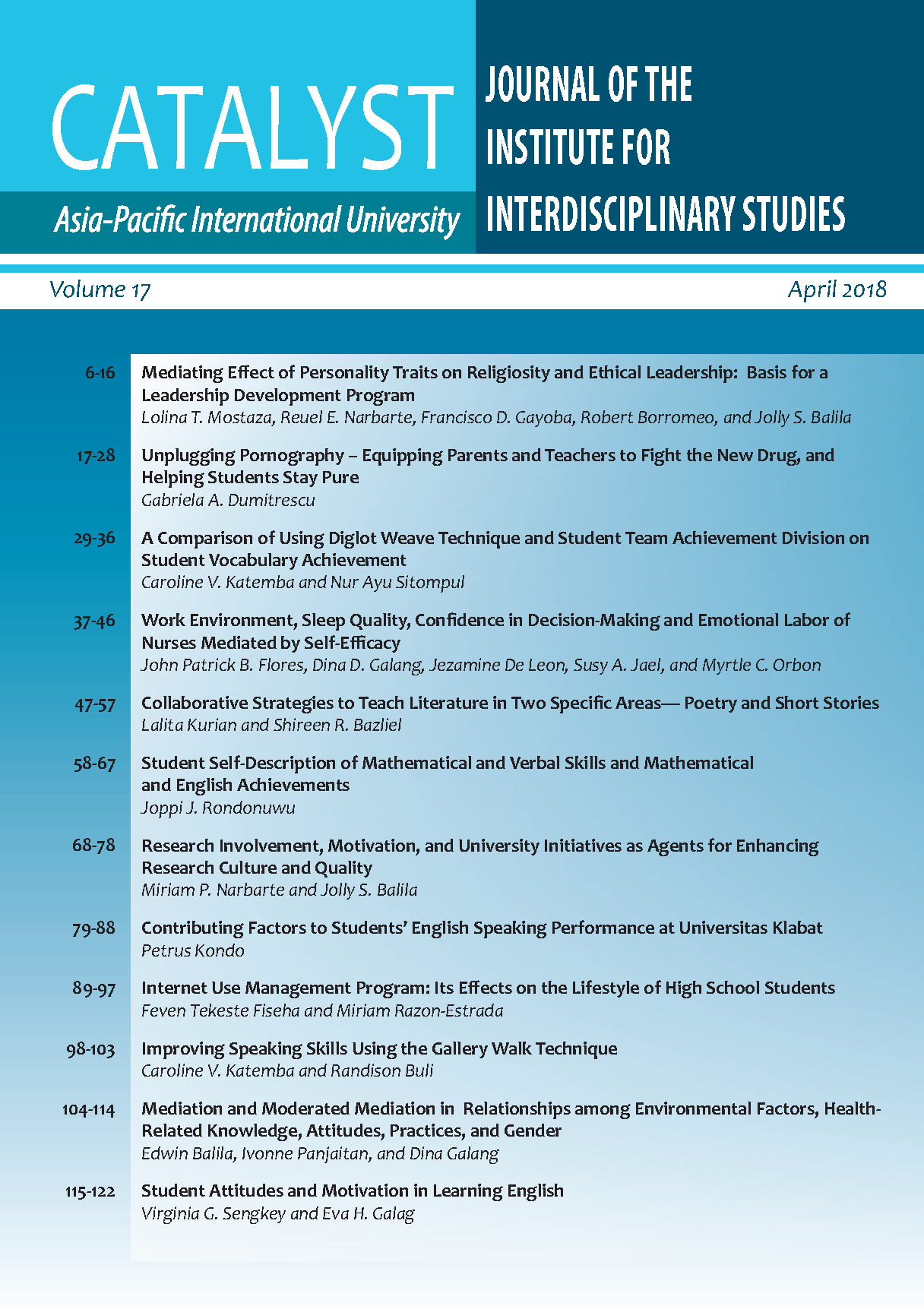Internet Use Management Program: Its Effects on the Lifestyle of High School Students
Main Article Content
Abstract
This study examined the effects of an Internet use management program on high school student lifestyles usinga quasi-experimental two-group pretest-posttest design. The experimental group (n = 51) were exposed to a four-week Internet use management program; the control group (n = 46) did not undergo any intervention. At baseline, the experimental group had fair dietary lifestyles, sleep patterns, and poor physical activity. The control group had fair dietary lifestyles and physical activity, but good sleep patterns. Both groups used the Internet moderately. After the intervention, the experimental group exhibited good dietary lifestyles and physical activity, very good sleeping patterns, and mild Internet use. The experimental group showed significant improvements in their lifestyles, while no significant differences were found between the control group’s baseline and endline scores. When both groups’ gain scores were compared, a significant difference was found in lifestyle scores, while the experimental group had higher gain scores in dietary lifestyle, physical activity, sleep patterns, and Internet use. The results of this study suggest that the Internet use management program was effective in promoting healthy lifestyle practices in diet, physical activity, sleep, and Internet use among high school students.
Article Details

This work is licensed under a Creative Commons Attribution-NonCommercial-NoDerivatives 4.0 International License.
Copyright: Asia-Pacific International University reserve exclusive rights to publish, reproduce and distribute the manuscript and all contents therein.
References
Cao, F., & Su, L. (2007). Internet addiction among Chinese adolescents: prevalence and psychological features. Child Care Health and Development, 33(3):275-281.
Caplan, S., Williams, D. & Yee, N. (2009). Problematic internet use and psychosocial well-being among MMO players. Computers in Human Behavior, 25(6): 1312-1319.
Choi, Y. (2007). Advancement of IT and seriousness of youth internet addiction. In International Symposium on the Counseling and Treatment of Youth Internet Addiction. Seoul, South Korea: National Youth Commission, 2007:20.
Davis, R. (2001). A cognitive-behavioral model of pathological internet use. Computers in Human Behavior, 17(2):187-195.
Gordon-Larsen, P., Nelson, M., & Popkin, B. (2004). Longitudinal physical activity and sedentary behavior trends: Adolescence to adulthood. American Journal of Preventive Medicine, 27(4): 277-283.
Hiquchi, S., Motohashi, Y., Liu, Y., & Maeda, A. (2005). Effects of playing a computer game using a bright display on presleep physiological variables, sleep latency, slow wave sleep and REM sleep. Journal of Sleep Research, 14(3):267-73.
Jang, K., Hwang, S., Choi, J. (2008). Internet addiction and psychiatric symptoms among Korean adolescents. Journal of School Health; 78(3):165-171.
Kim, J., Chun, B. (2005). Association of internet addiction with health promotion lifestyle profile and perceived health status in adolescents. Journal of Preventive Medicine & Public Health, 38(1):53–60.
Kim, Y., Park, J., Kim, S. Jung, I., Lim, Y., Kim, J. (2010). The effects of Internet addiction on the lifestyle and dietary behavior of Korean adolescents. Nutrition Research and Practice, 4(1):5157. Retrieved from www.http: doi: 10.4162/nrp.2010.4.1.51
Ko, C., Yen, J., Chen, C., Yeh, Y., & Yen, C. (2009). Predictive values of psychiatric symptoms for Internet addiction in adolescents: a 2-year prospective study. Archives of Pediatric and Adolescent Medicine, 163 (10), 937-43.
Majeed, B. (2003). Knowledge, attitudes, and practices of adolescent school girls towards dietary habits and physical activity. Saddam College of Medicine, Community Medicine. Retrieved from https://pdfs.semanticscholar.org/1c78/12648849376c2010ccccac536e3b4fab37a7.pdf
Owens, J. (2004).The electronic sandman: the impact of the media on adolescent sleep. Sleep 27(1):15-6.
Poli, R., & Agrimi, E. (2012). Internet addiction disorder: Prevalence in an Italian student population. Nordic Journal of Psychiatry 66(1): 55-59. Retrieved from www.http: doi: 10.3109/08039488.2011.605169
Roszanadia, R., & Norazmir, M. (2011). Knowledge, attitude and practice on healthy eating among special needs boarding school students. International Journal of Diary Science. Retrieved from www.http: DOI: 10.3923/ijds.2011.
Savige, G, Macfarlane, A., Ball, K., Worsley, A., Crawford, D. (2007). Snacking behaviors of adolescents and their association with skipping meals. International Journal of Behavioral Nutrition and Physical Activity 4:36. Retrieved from www. https://doi.org/10.1186/1479-58684-36
Sharf, R. (2011). Theories of psychotherapy and counseling: Concepts and cases (5th edition). Belmont, CA: Brooks/Cole.
Wang, L, Luo, J., Luo, J., Gao, W., & Kong, J. (2012). The effect of Internet use on adolescents’ lifestyles: A national survey. Computers in Human Behavior. 28(6): 2007-2013. Retrieved from https://doi.org/10.1016/ j.chb.2012.04.007.
Young, K. (2007). Cognitive behavior therapy with Internet addicts: treatment outcomes and implications. Cyber Psychology & Behavior 10(5):671-679.
Young, K., & Abreu, C. (2010). Internet Addiction. A Handbook and Guide to Evaluation and Treatment. Hoboken, New Jersey; ISBN 978-0-470-55116-5.
Yuen, C., & Lavin, M. (2004). Internet dependence in the collegiate population: The role of shyness. Cyber Psychology & Behavior 7(4):379-383.


